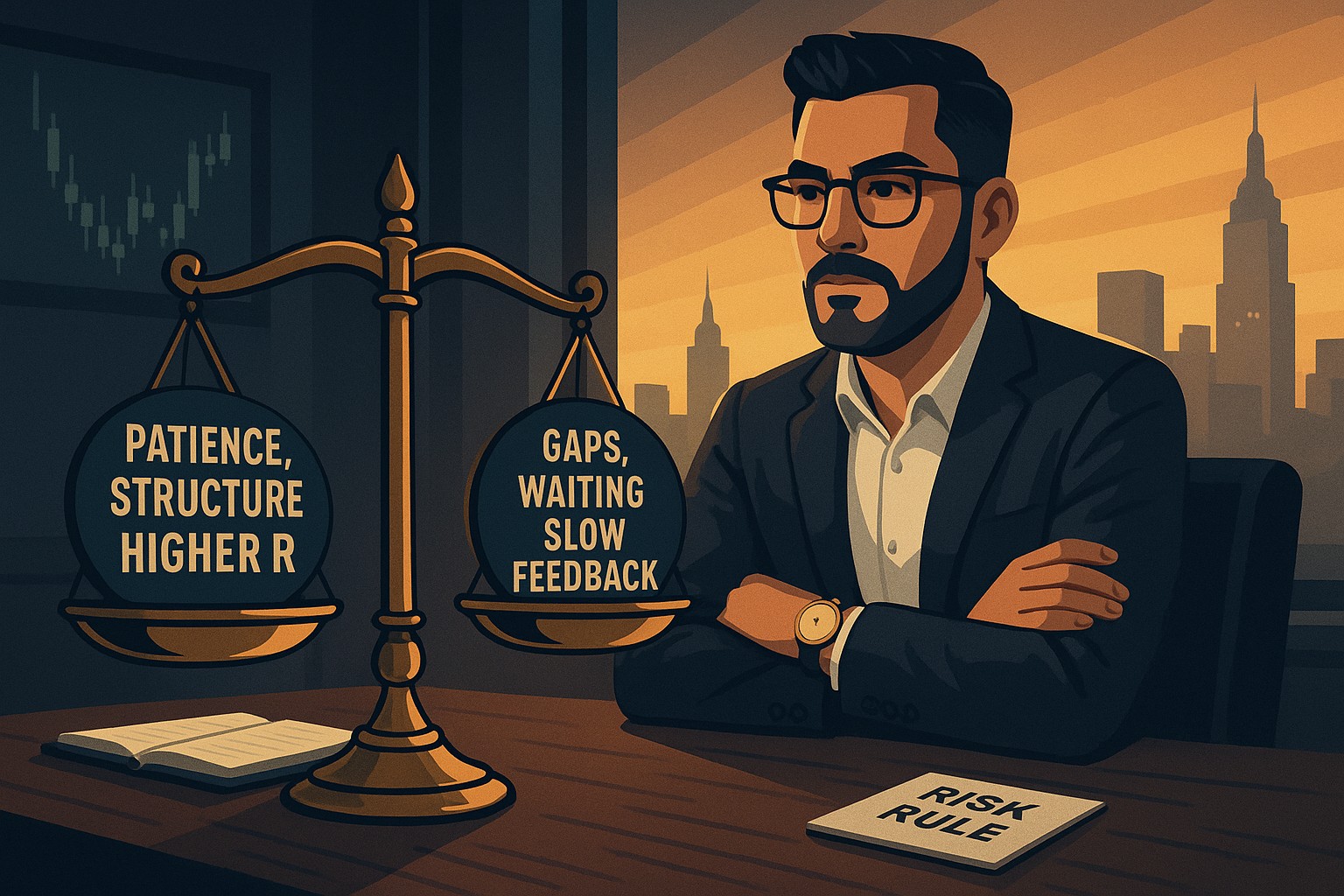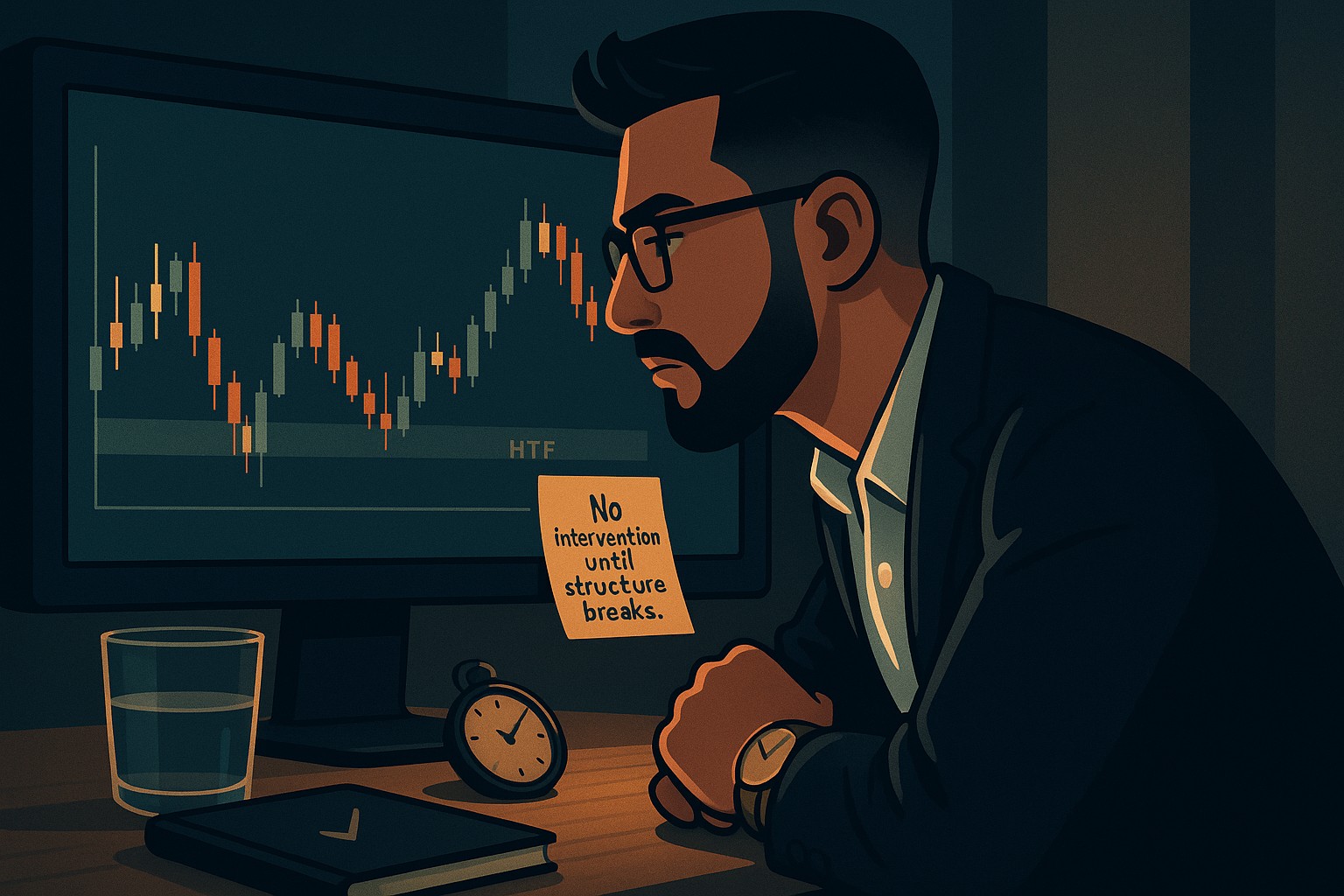Introduction to Swing Trading
2025-10-07 09:27:36
Every trader eventually faces the question: “How fast should I trade?”
Some crave the thrill of intraday volatility, watching candles dance minute by minute. Others prefer the calm pace of multi-day swings, where structure speaks louder than noise. Between these two extremes lies a rhythm that balances both - and that’s where swing trading thrives.

Swing trading isn’t just another strategy. It’s a tempo - the space between speed and stillness, where timing meets patience and clarity replaces chaos. If you’re new and want cleaner reads with less noise, start by learning how to read the higher timeframes with multi-timeframe analysis; it’s the backbone of swing decisions.
What Swing Trading Really Means
Swing trading is the art of capturing the market’s natural rhythm - those meaningful “swings” that occur as price expands, corrects, and trends again. While scalpers hunt for seconds and day traders fight for hourly moves, swing traders wait for the market to breathe. They enter when momentum is confirmed and exit when it fades.
The average trade lasts a few days to a few weeks, depending on volatility. But more importantly, swing traders focus on context - they study the daily narrative of price rather than chasing every candle. It’s less about being fast and more about being aligned. When you’re ready to define risk and targets clearly, revisit the essentials of risk management, stops, and position sizing to protect those swings.
Swing Trading vs. Day Trading - A Balanced Comparison

It’s easy to pit one style against the other, but both have strengths. The best traders understand how each serves a different personality and lifestyle.
| Aspect | Day Trading | Swing Trading |
|---|---|---|
| Time Commitment | Requires full attention during market hours; ideal if you can monitor screens 4–8 hours and follow a tight day-trading routine. | Flexible - analyze once or twice daily, set alerts, manage around your schedule. |
| Trade Duration | Seconds to hours; flat by session close. | 2 days to 2 weeks; riding trend legs, not intraday noise. |
| Volatility Exposure | Intraday whipsaws; minimal overnight risk. | Overnight/weekend gaps; benefits from larger, cleaner moves. |
| Stress Level | Fast, mentally intense; rapid decisions. | Slower, deliberate; patience replaces urgency. |
| Reward Potential | Smaller moves, higher frequency - compounding small edges. | Fewer trades, higher R multiples (1:3+) if trends extend. |
| Ideal Trader Type | Action-oriented, thrives on quick cycles and intraday playbooks like a structured indices open strategy. | Strategic, patient, values work–life balance and higher-TF confluence. |
Both paths lead to growth - they simply train different muscles. Day trading sharpens execution and adaptability. Swing trading builds perspective, emotional control, and rhythm. Many traders evolve through both: they learn speed from intraday playbooks, then deepen conviction with higher-timeframe reads.
Why Swing Trading Fits Real Life
Jobs, families, studies - life doesn’t always allow 8 hours of screen time. Swing trading respects that reality. You can analyze after work, set alerts, place orders, and then step back. It’s a realistic bridge between markets and life, especially if you’re still building consistency. For clearer decision-making under pressure, pair your plan with a simple mental framework like the ideas in How to Think Like a Price Action Trader.
The Pros and Cons of Swing Trading

Pros - Why Swing Trading Works So Well
- Clarity Over Chaos – Higher timeframes (H4–Daily) filter noise, revealing the structure institutions care about.
- Better Work–Life Balance – Evenings to plan, days to live; analysis takes minutes, not hours.
- Emotionally Calmer – You trade less from adrenaline and more from rules; journaling is simpler and more honest.
- Bigger Reward Potential – When trend legs run, a single well-planned trade can deliver 3R–6R.
- Ideal for Learning Structure – Cleaner highs/lows, liquidity pools, and retracements accelerate learning; see also the big-picture drivers in Central Banks & Interest Rates.
Cons - What You Must Master
- Overnight & Weekend Risk – Gaps happen; use sizing, hedging rules, and pre-news plans (review CPI/NFP playbooks).
- Delayed Feedback Loop – Fewer trades mean slower iteration; compensate with rigorous journaling and targeted forward testing.
- The Waiting Game – Boredom and over-management are common; define when not to touch the trade.
- False Confidence – “Set and forget” can drift into neglect; schedule check-ins and rule-based updates.
Swing trading rewards calm thinkers - but punishes those who confuse slowness with safety. Patience only pays when paired with precision and risk discipline (bookmark Why Risk Management Is the Only Edge That Lasts).
The Hidden Strength: Mental Recovery

Day trading drains decision energy; you win or lose quickly and immediately re-engage. Swing trading builds mental recovery into the cadence: analyze → plan → execute → step away. That breathing room clarifies cause-and-effect and reduces impulsive tinkering. If you’re coming from intraday, this slower cadence often improves your win quality and emotional control.
The Psychology Behind It

The challenge isn’t the setup - it’s the stillness. Swing traders learn to hold conviction, tolerate uncertainty, and manage themselves when price goes sideways for days. If psychology is your bottleneck, start with The Mental Game of Execution and add one rule you’ll follow after entry (e.g., “no intervention until HTF structure breaks”).
Real-Life Analogy: The Long-Distance Runner

Scalpers sprint; day traders run mid-distance; swing traders are marathoners. They pace, read terrain, and conserve energy for decisive moves. The market, like a marathon, rewards endurance over excitement - especially when your plan and position sizing method make finishing strong the default.
Final Thoughts
Swing trading is not slower - it’s smarter. It teaches you how to think, not just react; how to hold conviction, not just clicks. It rewards those who combine structure with serenity, and it builds habits that extend beyond markets: patience, preparation, and peace of mind. When you learn to trust time instead of fighting it, you stop chasing trades and start catching meaning - that’s when trading evolves from a hustle into a rhythm.
Start Practicing with Confidence - Risk-Free!
- Trade forex, indices, gold, and more
- Access ACY, MT4, MT5, & Copy Trading Platforms
- Practice with zero risk
It’s time to go from theory to execution - risk-free.
Create an Account. Start Your Free Demo!
Check Out My Contents:
Strategies That You Can Use
Looking for step-by-step approaches you can plug straight into the charts? Start here:
- How To Trade & Scalp Indices at the Open Using Smart Money Concepts (SMC)
- How to Trade Breakouts Effectively in Day Trading with Smart Money Concepts
- Complete Step-by-Step Guide to Day Trading Gold (XAU/USD) with Smart Money Concepts (SMC)
- The Power of Multi-Timeframe Analysis in Smart Money Concepts (SMC)
- Forex Trading Strategy for Beginners
- Mastering Candlestick Pattern Analysis with the SMC Strategy for Day Trading
- How to Use Fibonacci to Set Targets & Stops (Complete Guide)
- RSI Divergence Trading Strategy for Gold: How to Identify and Trade Trend Reversals
- Stochastics Trading Secrets: How to Time Entries in Trending Markets using Stochastics
- Gold Trading Stochastics Strategy: How to Trade Gold with 2R - 3R Targets
- RSI Hidden Divergence Explained: How to Spot Trend Continuations Like a Pro
- Moving Averages Trading Strategy Playbook
- Mastering Fibonacci Trading Psychology - Trusting the Levels, Managing the Mind
- Mastering Price Action at Key Levels - How to Spot, Trade, and Win at the Most Crucial Zones
- Mastering Retests: How to Enter with Confirmation After a Breakout
Indicators / Tools for Trading
Sharpen your edge with proven tools and frameworks:
- The Ultimate Guide to Risk Management in Trading - A Complete Compilation for 2025
- Moving Averages Trading Strategy Playbook
- How to Think Like a Price Action Trader
- Mastering Fibonacci Trading Psychology - Trusting the Levels, Managing the Mind
How To Trade News
News moves markets fast. Learn how to keep pace with SMC-based playbooks:
- Why Smart Money Concepts Work in News-Driven Markets - CPI, NFP, and More
- How to Trade NFP Using Smart Money Concepts (SMC)-A Proven Strategy for Forex Traders
- How to Trade CPI Like Smart Money - A Step-by-Step Guide Using SMC
Learn How to Trade US Indices
From NASDAQ opens to DAX trends, here’s how to approach indices like a pro:
- How to Start Trading Indices and Get into the Stock Market with Low Capital (2025 Guide)
- Best Indices to Trade for Day Traders | NASDAQ, S&P 500, DAX + Best Times to Trade Them
- How To Trade & Scalp Indices at the Open Using Smart Money Concepts (SMC)
- NAS100 - How to Trade the Nasdaq Like a Pro (Smart Money Edition)
How to Start Trading Gold
Gold remains one of the most traded assets - - here’s how to approach it with confidence:
- How to Swing Trade Gold (XAU/USD) Using Smart Money Concepts: A Simple Guide for Traders
- Complete Step-by-Step Guide to Day Trading Gold (XAU/USD) with Smart Money Concepts (SMC)
- The Ultimate Guide to Backtesting and Trading Gold (XAU/USD) Using Smart Money Concepts (SMC)
- Why Gold Remains the Ultimate Security in a Shifting World
- How to Exit & Take Profits in Trading Gold Like a Pro: Using RSI, Range Breakdowns, and MAs as Your Confluence
How to Trade Japanese Candlesticks
Candlesticks are the building blocks of price action. Master the most powerful ones:
- Mastering the Top Japanese Candlesticks: The Top 5 Candlesticks To Trade + Top SMC Candlestick Pattern
- How to Trade Candlestick Patterns with High Probability: A Complete Guide for Beginners
- The Top Japanese Candlestick Guide: What is an Engulfing Pattern and How to Trade It?
- Piercing Pattern Candlestick Explained: How to Trade It - Step-By-Step Guide
- Morning & Evening Star Candlestick Patterns - How to Trade Market Reversals with Confidence
How to Start Day Trading
Ready to go intraday? Here’s how to build consistency step by step:
- 5 Steps to Start Day Trading: A Strategic Guide for Beginners
- 8 Steps How to Start Forex Day Trading in 2025: A Beginner’s Step-by-Step Guide
- 3 Steps to Build a Trading Routine for Consistency and Discipline - Day Trading Edition
- The Ultimate Guide to Understanding Market Trends and Price Action
- Trading with Momentum: The Best Trading Session to Trade Forex, Gold and Indices
Learn how to navigate yourself in times of turmoil
Markets swing between calm and chaos. Learn to read risk-on vs risk-off like a pro:
- How to Identify Risk-On and Risk-Off Market Sentiment: A Complete Trader’s Guide
- How to Trade Risk-On and Risk-Off Sentiment - With Technical Confirmation
- The Ultimate Guide to Understanding Market Trends and Price Action
Want to learn how to trade like the Smart Money?
Step inside the playbook of institutional traders with SMC concepts explained:
- Why Smart Money Concepts Work: The Truth Behind Liquidity and Price Action
- Mastering the Market with Smart Money Concepts: 5 Strategic Approaches
- Understanding Liquidity Sweep: How Smart Money Trades Liquidity Zones in Forex, Gold, US Indices
- The SMC Playbook Series Part 1: What Moves the Markets? Key Drivers Behind Forex, Gold & Stock Indices
- The SMC Playbook Series Part 2: How to Spot Liquidity Pools in Trading-Internal vs External Liquidity Explained
- Fair Value Gaps Explained: How Smart Money Leaves Footprints in the Market
- Accumulation, Manipulation, Distribution: The Hidden Cycle That Runs Every Market
- Institutional Order Flow - Reading the Market Through the Eyes of the Big Players
- London Session Trading Secrets: How Smart Money Sets the High & Low of the Day
- Mastering the New York Session - Smart Money Concepts Guide
Master the World’s Most Popular Forex Pairs
Forex pairs aren’t created equal - - some are stable, some are volatile, others tied to commodities or sessions.
- The Top 5 All-Time Best Forex Pairs to Trade
- Top Forex Pairs Beyond the Big Five
- EUR/USD: The King of Forex
- USD/JPY: The Fast Mover
- GBP/USD: The Volatile Cable
- AUD/USD: The Commodity Currency
- USD/CAD: The Oil-Backed Pair
- GBP/JPY: How to Trade The Beast
- Asian & London Session Secrets
- Mastering the New York Session
Stop Hunting 101
If you’ve ever been stopped out right before the market reverses - - this is why:
- Stop Hunting 101: How Swing Highs and Lows Become Liquidity Traps
- Outsmarting Stop Hunts: The Psychology Behind the Trap
- How to Lessen Risk From Stop Hunts in Trading
- How Stop Hunts Trigger Revenge Trading - Breaking the Pain Cycle
- How to Accept Stop Hunts Without Losing Discipline - Shifting From Frustration to Focus
Trading Psychology
Mindset is the deciding factor between growth and blowups. Explore these essentials:
- The Mental Game of Execution - Debunking the Common Trading Psychology
- Managing Trading Losses: Why You Can Be Wrong and Still Win Big in Trading
- The Hidden Threat in Trading: How Performance Anxiety Sabotages Your Edge
- Why 90% of Retail Traders Fail Even with Profitable Trading Strategies
- Top 10 Habits Profitable Traders Follow Daily to Stay Consistent
- Top 10 Trading Rules of the Most Successful Traders
- Top 10 Ways to Prevent Emotional Trading and Stay Disciplined in the Markets
- Why Most Traders Fail - Trading Psychology & The Hidden Mental Game
- Emotional Awareness in Trading - Naming Your Triggers
- Discipline vs. Impulse in Trading - Step-by Step Guide How to Build Control
- Trading Journal & Reflection - The Trader’s Mirror
- Overcoming FOMO & Revenge Trading in Forex - Why Patience Pays
- Risk of Ruin in Trading - Respect the Math of Survival
- Identity-Based Trading: Become Your Trading System for Consistency
- Trading Psychology: Aligning Emotions with Your System
- Mastering Fear in Trading: Turn Doubt into a Protective Signal
- Mastering Greed in Trading: Turn Ambition into Controlled Growth
- Mastering Boredom in Trading: From Restless Clicking to Patient Precision
- Mastering Doubt in Trading: Building Confidence Through Backtesting and Pattern Recognition
- Mastering Impatience in Trading: Turn Patience Into Profit
- Mastering Frustration in Trading: Turning Losses Into Lessons
- Mastering Hope in Trading: Replacing Denial With Discipline
- When to Quit on Trading - Read This!
- The Math of Compounding in Trading
- Why Daily Wins Matter More Than Big Wins
- Scaling in Trading: When & How to Increase Lot Sizes
- Why Patience in Trading Fuels the Compounding Growth
- Step-by-Step Guide on How to Manage Losses for Compounding Growth
- The Daily Habits of Profitable Traders: Building Your Compounding Routine
- Trading Edge: Definition, Misconceptions & Casino Analogy
- Finding Your Edge: From Chaos to Clarity
- Proving Your Edge: Backtesting Without Bias
- Forward Testing in Trading: How to Prove Your Edge Live
- Measuring Your Edge: Metrics That Matter
- Refining Your Edge: Iteration Without Overfitting
- The EDGE Framework: Knowing When and How to Evolve as a Trader
- Scaling Your Edge: From Small Account to Consistency
Market Drivers
- Central Banks and Interest Rates: How They Move Your Trades
- Inflation & Economic Data: CPI Trading Strategy and PPI Indicator Guide
- Geopolitical Risks & Safe Havens in Trading (Gold, USD, JPY, CHF)
- Jobs, Growth & Recession Fears: NFP, GDP & Unemployment in Trading
- Commodities & Global Trade: Oil, Gold, and Forex Explained
- Market Correlations & Intermarket Analysis for Traders
Risk Management
The real edge in trading isn’t strategy - it’s how you protect your capital:
- Mastering Risk Management: Stop Loss, Take Profit, and Position Sizing
- Why Risk Management Is the Only Edge That Lasts
- How Much Should You Risk per Trade? (1%, 2%, or Less?)
- The Ultimate Risk Management Plan for Prop Firm Traders - Updated 2025
- Mastering Position Sizing: Automate or Calculate Your Risk Like a Pro
- Martingale Strategy in Trading: Compounding Power or Double-Edged Sword?
- How to Add to Winners Using Cost Averaging and Martingale Principle with Price Confirmation
Suggested Learning Path
If you’re not sure where to start, follow this roadmap:
- Start with Trading Psychology → Build the mindset first.
- Move into Risk Management → Learn how to protect capital.
- Explore Strategies & Tools → Candlesticks, Fibonacci, MAs, Indicators.
- Apply to Assets → Gold, Indices, Forex sessions.
- Advance to Smart Money Concepts (SMC) → Learn how institutions trade.
- Specialize → Stop Hunts, News Trading, Turmoil Navigation.
This way, you’ll grow from foundation → application → mastery, instead of jumping around randomly.
Follow me for more daily market insights!
Jasper Osita - LinkedIn - FXStreet - YouTube
This content may have been written by a third party. ACY makes no representation or warranty and assumes no liability as to the accuracy or completeness of the information provided, nor any loss arising from any investment based on a recommendation, forecast or other information supplies by any third-party. This content is information only, and does not constitute financial, investment or other advice on which you can rely.















